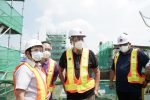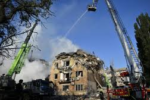No signs of COVID-19 slowing down, 94 areas in the country still on highest infection alert-DOH

FILE PHOTO
The Department of Health (DOH) on Saturday said COVID-19 cases in the country have yet to show signs of slowing down as 94 areas remain in the highest virus alert level, Metro Manila being the epicenter are still growing.
“Nakikita rin po natin, na kahit dito sa [National Capital Region] tumataas pa rin po ang ating mga kaso. We have 8 percent increase of our cases from the previous seven days kung ikumpara natin, nationally, if we look at that, we still have a positive 2-week growth rate,” DOH Undersecretary Maria Rosario Vergeire said
Vergeire explained 94 areas are under Alert Level 4, 18 areas are under Alert Level 3, 9 areas are currently placed under Alert Level 2, while no area in the country is under Alert Level 1.
Under the highest alert level, hospital beds dedicated for COVID-19 patients in a certain area are more than 70 percent occupied. This is distinct from the new alert level system for quarantine restrictions.
She added that the average daily attack rate (ADAR) in the region is at 18 percent in the past 2 weeks, higher from 4 weeks ago.
ADAR is the number of new cases in a city or province over a two-week period, divided by the population of the city or province.
NCR, she said, had an average of 5,825 cases in the past week, higher by 8 percent than 5,410 recorded from Sept. 4 to Sept. 10.
Regions that are still under the high-risk case classification for having high ADAR and positive 2-week growth rate are the following:
- NCR
- Calabarzon
- Central Luzon
- Caraga
- Cordillera Administrative Region
- Cagayan Valley
- Ilocos Region
- Davao Region
- Zamboanga Peninsula
- Western Visayas
- Northern Mindanao
“Pataas pa rin po ang ating mga kaso,” she said.
The Philippines is struggling to cope with the new wave of COVID-19 infections likely driven by the community transmission of the more transmissible Delta variant, which has seen hospitals filled to capacity.
Earlier in the day, OCTA Research fellow Guido David said Metro Manila is showing “early indications” of reaching the peak.
David added that the reproduction (R) number in the region decreased to 1.22 while the positivity rate also went down to 22 percent.
“Efforts must be sustained because trends may still reverse. Cases may increase again if care is not taken,” the analyst’s note read.
But Vergeire said it is too early to tell whether the region already reached its peak. It can only reach its peak, she noted, if a downward COVID-19 trend is evident and sustained.
Metro Manila posted almost 8,000 new cases in just a day last week, then it went down to around 5,000 to 5,800 cases daily.
“Hindi pa po natin masabi sa ngayon, ito pong peak, pag sinabi niyo, ‘yan na ‘yung mataas na makukuha natin na numero at pagkatapos noon ay patuloy na bababa,” she said.
(We cannot say right now that we already reached our peak. If you say there’s a peak, the cases are on a downward trend)
“Tataas bababa… at this point, in our analysis, hindi pa po natin nakikita na nagpe-peak na po tayo sa ating mga kaso.”
(It’s fluctuating. We cannot say we already reached the peak if this is the case.)
Health Secretary Francisco Duque III on Thursday said at least 91 percent of provinces and cities in the the Philippines are still classified as high risk for COVID-19
The Philippines recorded over 20,000 new COVID-19 cases on Friday, with a near-month high fresh deaths at over 300.






